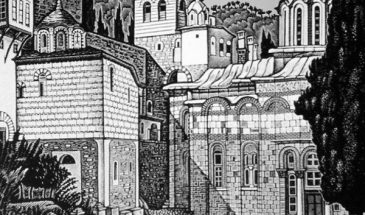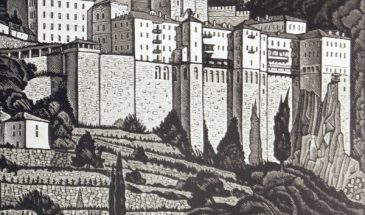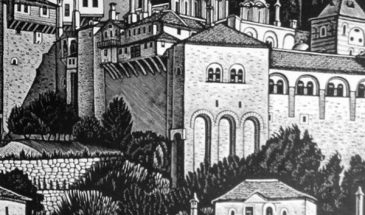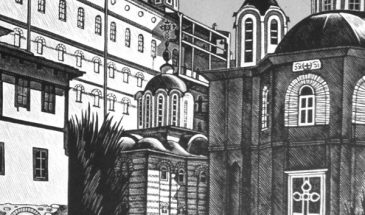- Overview
- Itinerary
- Included
- Not Included
- Gallery
- Booking
Three-Day Mount-Athos B’
Mountain Athos is the top site to experience simultaneously the imprint of historical time together with its absolute absence. Throughout the course of history, the achievements of Greek civilization are preserved not only to maintain the knowledge of the past, nor just for esthetic reasons — they are also practiced in the daily routines of the monks, thus creating a bridge between history and the modern world.
1st day (on foot)
Ouranoupoli – Hilandariou Monastery – Zografou Monastery – Esphigmenou Monastery
2nd day (by car)
Vatopedi Monastery – Skete of Prophet Elijah – Iveron Monastery
3rd day (by car)
Karyes – Koutloumousiou Monastery – Skete of St. Andrew the Apostle (Sarai) – Xeropotamou Monastery – Simonos Petra (Simonopetra) Monastery – Ouranoupoli
Itineraries
OURANOUPOLI
1st day-Morning
You will first stop at the pilgrim’s office to get the entry permit for Mt. Athos.Hilandariou Monastery
1st stop
From Ouranoupoli you’ll reach the small dock of Hilandariou Monastery. In the monastery, you will be given the opportunity to pay homage to the icons of Panagia Tricherousa (the Virgin with Three Hands), Panagia Odigetria (Our Lady of Guides) and Panagia Galactotrofousa (the Milk-Giving Mother of God). In the monastery, the tombs and relics of several saints are also kept. Among them are a part of the skull of St. Efthechios and parts of the relics of St. John the Baptist.Zografou Monastery
2nd stop
You’ll, then, walk to Zografou Monastery. Among the holy heirlooms of the monastery you’ll see: one large wonderworking icon of St. George the Megalomartyr (the Great Martyr) and one of Panagia Proanangelomeni or Akathistou (of the Akathist Hymn) and the wonderworking icon of Panagia Epakouousa (Virgin Mary who heard the prayers of the Saint). The monastery, also, houses the relics of several saints.Esphigmenou Monastery
3rd stop
After the Monastery of Zografos, you’ll visit Esphigmenou Monastery, which, according to tradition, was founded by Pulcheria (408 – 455). The katholicon is dedicated to the Resurrection of Christ. The wonderworking icon of Panagia Arsaniotissa is kept here. Also, a very important heirloom is kept in the monastery, Pulcheria’s cross, which consists of pearls and three large emeralds. It is worth mentioning that in the late 10th century the founder of monasticism in Rous, Hosios Antonios of Kiev, received the monastic tonsure and spent time in the particular monastery. Also, St. Gregory Palamas, who became the Archbishop of Thessaloniki in 1335, had spent time as a monk in the same monastery.Esphigmenou Monastery
4th stop
After the Monastery of Zografos, you’ll visit Esphigmenou Monastery, which, according to tradition, was founded by Pulcheria (408 – 455). The katholicon is dedicated to the Resurrection of Christ. The wonder-working icon of Panagia Arsaniotissa is kept here. Also, a very important heirloom is kept in the monastery, Pulcheria’s cross, which consists of pearls and three large emeralds. It is worth mentioning that in the late 10th century the founder of monasticism in Rous, Hosios Antonios of Kiev, received the monastic tonsure and spent time in the particular monastery. Also, St. Gregory Palamas, who became the Archbishop of Thessaloniki in 1335, had spent time as a monk in the same monastery.Hilandariou Monastery
5th stop
After Esfigmenou Monastery, you will return to Hilandariou Monastery and attend the Evening Prayer as well as dine in the Refectory together with the monks and the other pilgrims. You will also spend the night there and experience the monastic way of life to the fullest.Vatopedi Monastery
2nd day - 1st stop
Attend the Holy Liturgy in Hilandariou Monastery. Have breakfast in the Refectory. Continue your tour with a visit to Vatopedi Monastery. It is the second largest complex of buildings in Mt. Athos after the one of Great Lavra. Vatopedi Monastery is home to many icons depicting Virgin Mary such as Panagia Pantanassa, Panagia Esfalmeni, Panagia Antifonitria, Panagia Paramythia, Panagia Ktitorissa, Panagia Vimatarissa, Panagia Pyrovlithissa, Panagia Eleousa, and Panagia Eleovrytissa. The sanctuary of the monastery houses the holy relics of several saints such as the holy skull and the intact ear of St. John Chrysostom, one of the most important teachers and illuminators of Christianity who was also the Archbishop of Constantinople. The holy skull of St. Gregory the Theologian is displayed as well, together with various holy heirlooms such as the three parts of Virgin Mary’s Holy Girdle. Other imperial and royal offerings kept in the sacristy are also worth seeing.Skete of Prophet Elijah
2nd stop
Leaving Vatopedi Monastery behind, you will head to the Skete of Prophet Elijah. The skete is organized as a commune and it is in the diocese of the Monastery of Pantokrator. It was established in 1757 by St. Paisios of Velitskovsky. The same saint also disseminated the nyptic theology and the tradition of mental prayer to the Slavic countries. Two large icons of Virgin Mary are kept in the skete: one of Panagia Galactotrofousa (the All-holy Virgin the Milk-giver) and the other of Tikhvin Dakriroousa (from the Russian village of Tikhvin). The skete houses the relics of several saints such as the left heel of St. Andrew Protoklitos (the First-called) as well as holy items such as pieces of the robes that Jesus and Mary wore.Iveron Monastery
3th stop
A visit to Iveron Monastery follows next. It is located on the north-east side of Mt. Athos. Here, you may pay homage to the wonderworking icon of Panagia the Portaitissa (All-holy Virgin of the Gate), one of the most famous and revered icons of the area. The icon was miraculously delivered to the monastery via sea in the early 11th century. Tradition has it that the icon used to belong to a devout widow that lived in Nice. When the iconoclasts arrived at her door and demanded that she handed it to them, the widow managed to convince them to let her keep it for another day. Meanwhile, she threw the icon in the sea. To her surprise, though, the icon rose from the water and begun to pull away until it completely vanished into the horizon. One night, many years later, the monks of Mt. Athos all of a sudden saw a beam of light. They could just barely make out that it was an icon of the Virgin approaching the shore. The Mother of God herself chose the monk worthy of pulling the icon on shore. In a rejoicing atmosphere, the icon was transferred to Iveron Monastery where it is housed until today. In the sacristy of the monastery, you may also see holy relics, gold-work embroidery vestments, the bag of the Emperor Ioannis Tsimiskis, the mantle of St. Gregory V and the will that he left. Also, a piece of the Holy Cross is kept here together with the many relics and various heirlooms that date back to the merciless Passions of Christ. Such heirlooms are pieces of the sponge, the reed, the cloak and the column, against which He was whipped. In Iveron Monastery you will attend the Evening Prayer and dine in the Refectory together with the monks and the other pilgrims. You’ll also be spending the night there and experiencing the monastic way of life to the fullest.Karyes
3rd day - 1st stop
Attend the Holy Liturgy in Iveron Monastery. Have breakfast in the Refectory. Your next destination is Karyes, the famous capital of the Monastic State of Mt. Athos, where the administrative head is based. The Administration consists of two bodies: the Holy Community and the Hiera Epistasia. Here, you may pay homage to one of the most revered icons of Our Lady, Axion Estin, located in Protaton, the central church of the peninsula. Tradition has it that before the specific icon an angel first chanted the renowned hymn of ‘Axion Estin.’ The Church of Protaton is one of the oldest ones in Mt. Athos. It was founded by St. Athanasios the Athonite during the first half of the tenth century and it was then renovated by Andronicus II Paleologos (1282-1328). Protaton is dedicated to the Dormition of the Virgin Mary. The chapel of St. John Prodromos is also located in the same area.Koutloumousiou Monastery
2nd stop
After Karyes, you’ll visit Koutloumousiou Monastery. The wonderworking icon of Panagia Fovera Prostasias (Our Lady the Great Protector) is kept in the katholicon of the church. The monastery also houses a piece of the Holy Cross and parts of the holy relics of Saint Anne and St. Gregory the Theologian.Skete of St. Andrew the Apostle (Sarai)
3rd stop
Continue with a visit to the Skete of St. Andrew the Apostle (Sarai) where important heirlooms are also kept. You will have the opportunity to pay homage to the wonderworking icon of Panagia Paramythia as well as to a part of the saint’s frontal bone.Monastery of Xeropotamou
4th stop
Complete your visit to the skete and walk to the Monastery of Xeropotamou. The beautiful and emblematic monastery is located in a lavish-green landscape, on the east of the Monastery of St. Panteleimon and the west of Simonopetra Monastery. Tradition has it that Empress Pulcheria (450 - 457) together with the Emperor Constantine VII Porphyrogenitus (913 - 959) and Romanus I Lecapenus (920 - 944) were the founders of the monastery. Nevertheless, it is most likely that Paul of Xeropotamos was, in fact, the founding father of the monastery.Monastery of Simonos Petras
5th stop
You will then be transferred by car to the Monastery of Simonos Petras (Simonopetra). The monastery rises on the brink of a rock and it is righteously considered the most emblematic and structure-challenging building in Mt. Athos. Built some 980ft above a remote shore, the monastery stands in the southwestern end of the mountain, like a hovering mass. It was founded by Hosios Simon in 1257 and its katholicon honors the Nativity of Christ. The icons of Our Lady that you may pay homage to are: Elpis Apelpismenon (Hope of the hopeless), Pantanassas (Most-holy Queen of all), Pammakaristos (All-blessed Mother of God) and Koimisis tis Theotokou (the Dormition of Virgin Mary). Also, the monastery is home to holy heirlooms such as a case where pieces of the Holy Cross are kept; a reliquary hosting the relics of several saints; the left hand of Mary Magdalene which remains intact for the past 2000 years as well as Gospels, holy utensils and gold-embroidered vestments.OURANOUPOLI
5th stop - Afternoon/Return
At this point your journey in Mt. Athos has come to an end. From the Monastery of Simonos Petra, you’ll depart for Ouranoupoli.- Transfers in Mt. Athos according to the schedule
- Marine transfer from/to Ouranoupoli
- Tour guide services
- Entry permit arrangements
A charge is needed for the entry permit to Mt. Athos.
- Eastern Orthodox Christians: 25,00€.
- Non- Orthodox Christians: 30,00€.
- Children: 10,00€.
Extra services:
- Pick-up and drop-off from/to your hotel or elsewhere












